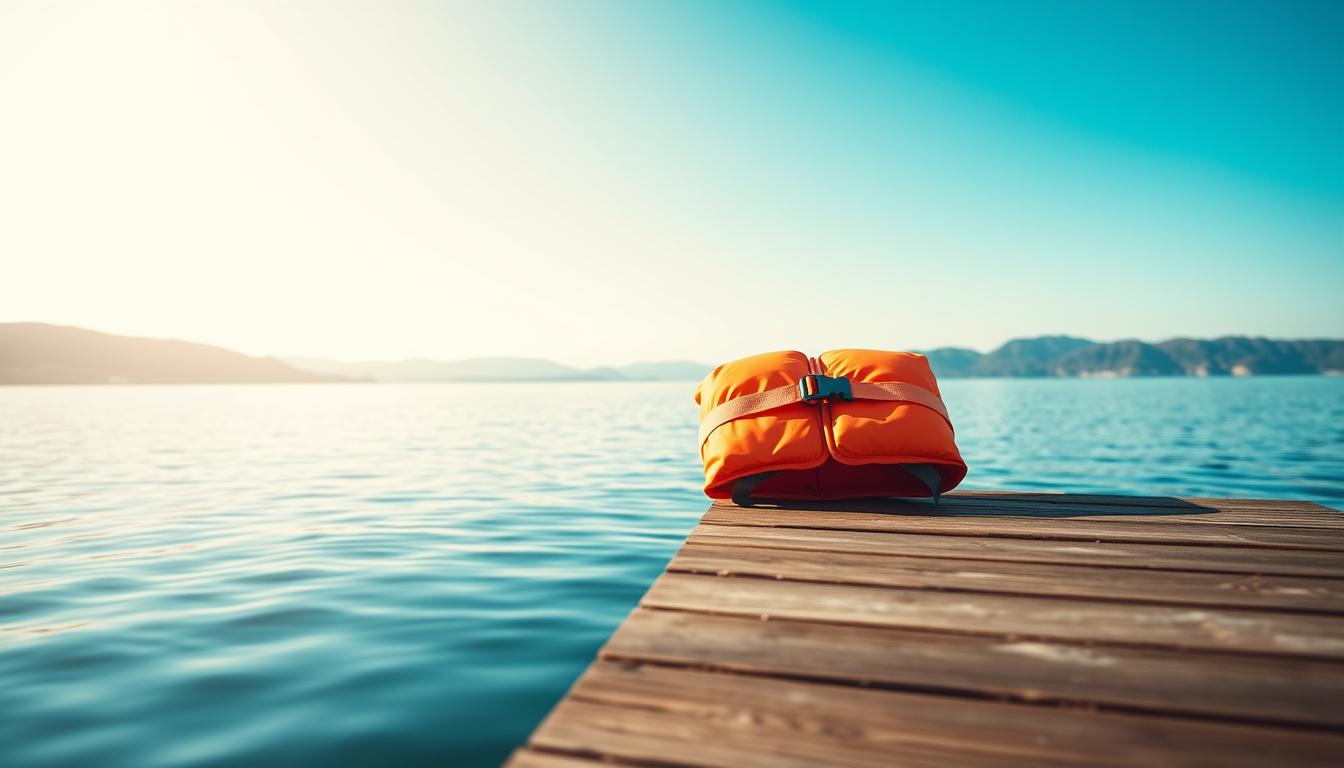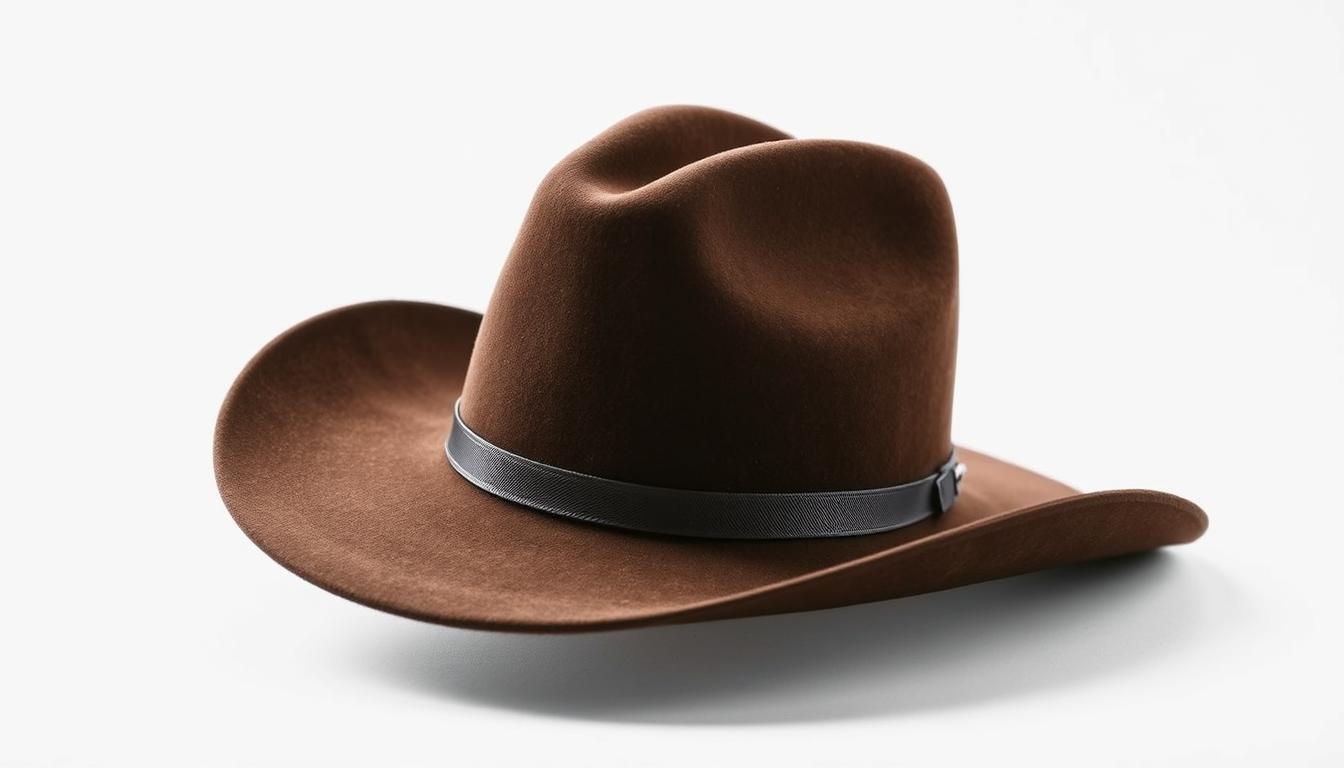Boating safety is all about knowing the rules, like life jacket age requirements. It’s important to understand when you don’t need to wear one. This varies by state and waterway. Safety is not just about rules; it’s about keeping you and your loved ones safe while having fun on the water.
Life jacket laws can be tricky. They depend on the boat type, water conditions, and where you are. Whether you’re a pro sailor or just out for a weekend, knowing these rules is key for a safe time on the water.
The Coast Guard and states have clear rules for life jackets. Things like boat size, water type, and who’s on board matter. Knowing these can help you stay safe and follow the law on your water adventures.
Key Takeaways
- Life jacket requirements differ by state and vessel type
- Age is a critical factor in determining life jacket mandates
- Federal and state regulations provide specific safety guidelines
- Penalties exist for non-compliance with life jacket laws
- Safety should always be the primary consideration on any watercraft
Understanding Federal Life Jacket Requirements
Boat safety rules are set by the U.S. Coast Guard to protect everyone on the water. They make sure all passengers have the right life jacket. This is to keep everyone safe while boating.
There are strict life jacket standards for different boats and situations. These rules help reduce risks and keep boaters of all ages safe from accidents.
Coast Guard Regulations and Guidelines
The Coast Guard focuses on important life jacket safety standards. They look at:
- How well life jackets fit and size for different ages
- What safety features are needed
- Where and when to wear life jackets on certain boats
- How to check and maintain life jackets
State-Specific Variations in Requirements
Even though there are federal rules, states can add their own. These extra rules might include:
- Rules about when kids need to wear life jackets
- More safety gear that boats must carry
- Special rules for certain waterways
Enforcement and Penalties
Not following life jacket laws can lead to serious consequences. You might face:
- Monetary fines from $50 to $500
- Having your boat taken away
- Being forced to take a safety course
Knowing these rules helps boaters stay safe and avoid legal trouble. It makes water activities more enjoyable for everyone.
Age-Based Life Jacket Laws Across Different States
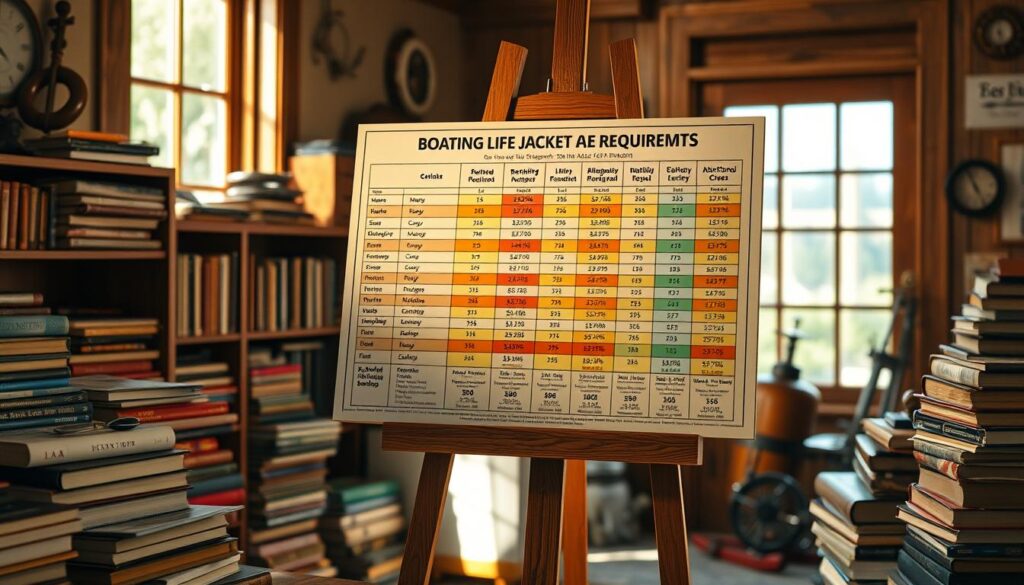
Figuring out life jacket rules can be tricky, like navigating through unknown waters. Each state in the U.S. has its own rules about when kids can ride a boat without a life jacket. This creates a mix of safety rules that boaters need to know well.
The rules for when kids need to wear life jackets differ a lot from state to state. Some states have strict rules for everyone, while others are more flexible. This depends on the type of boat and the water conditions.
- California requires children under 13 to wear life jackets on all boats under 26 feet
- Florida mandates life jackets for children under 6 on any vessel
- New York enforces life jacket use for children under 12 during boating activities
Parents should think about a few things when deciding if kids can boat without life jackets:
- Specific state regulations
- Boat type and size
- Water conditions
- Child’s swimming ability
Boating safety experts say to check local rules before you go boating. Even when the law doesn’t require it, wearing a life jacket is the safest choice for kids of all ages.
Knowing the different age limits for life jackets on boats helps make boating safer and more fun for families all over the U.S.
How Old Do You Have to Be to Not Wear a Life Jacket on a Boat
Boating rules about life jackets can be confusing. Knowing when you don’t need one depends on several important factors. Let’s look at the key guidelines for staying safe on the water and understanding your legal rights.
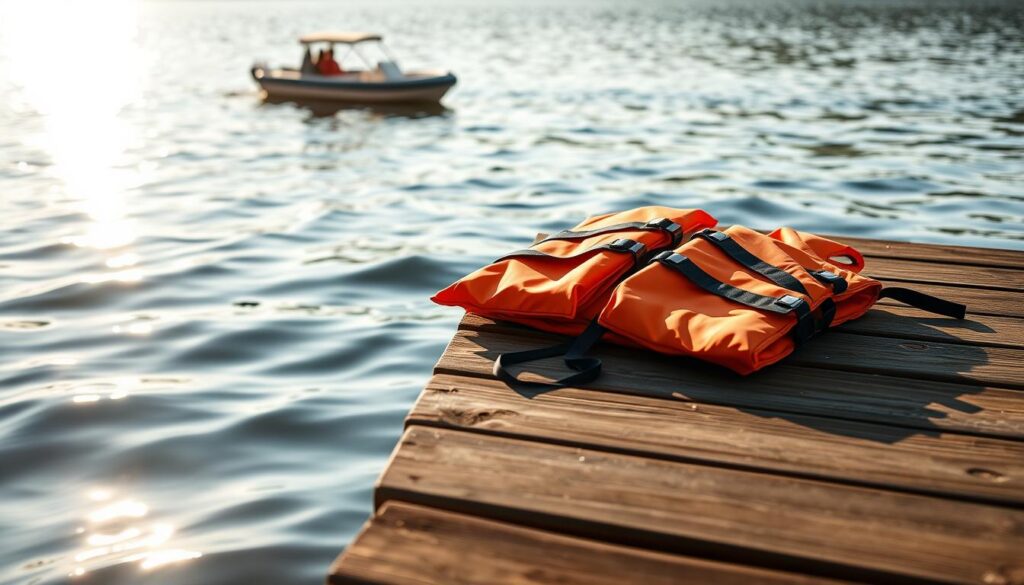
When thinking about not wearing a life jacket on a boat, age and boat type are key. Different places and boat types have their own rules that every boater needs to know.
Age Requirements by Vessel Type
Children’s life jacket rules change a lot depending on the boat type:
- Motorboats under 16 feet: Strict child safety rules
- Larger vessels: Less strict rules
- Personal watercraft: The strictest safety rules
Exceptions to Standard Rules
Even with safety first, there are times when you might not need a life jacket:
- Adults watching kids in enclosed cabins
- Recreational boats in calm weather
- Approved zones in some states
Special Considerations for Different Waterways
Waterway features greatly affect life jacket rules. Coastal waters, inland lakes, and rivers each have their own safety rules. Things like water temperature, boat traffic, and local conditions decide when you can skip the life jacket.
Always put safety first and check local rules before boating. Knowing these guidelines helps you stay safe and enjoy your time on the water.
Safety Considerations Beyond Legal Requirements
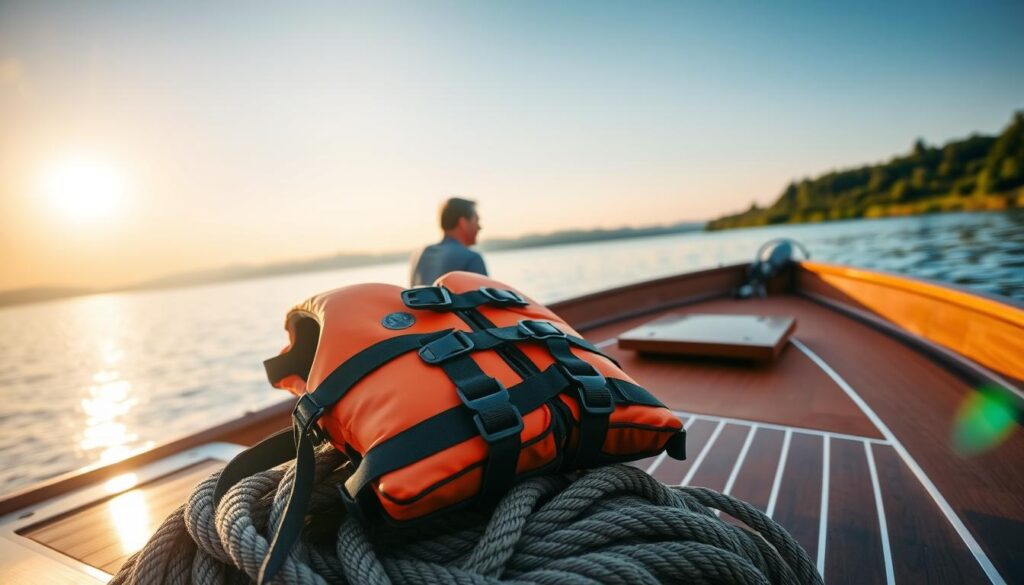
Boating safety is more than just following the law. It’s about making sure everyone on the water is safe. Knowing the boating age rules is just the start of keeping everyone safe.
Choosing the right life jacket is more than just meeting the law. Experienced boaters look at several important factors:
- Personal swimming ability
- Water conditions and temperature
- Type of watercraft
- Individual physical fitness
Different waters have their own dangers that laws might not cover. Recreational boaters should always put personal safety first, not just follow age rules.
| Safety Factor | Recommended Action |
|---|---|
| Inexperienced Swimmers | Always wear life jacket regardless of age |
| Rough Water Conditions | Use additional safety precautions |
| Remote Waterways | Carry emergency communication devices |
Maritime experts say life jackets are key safety gear, not just extras. By being proactive about safety, boaters can lower the risks of boating.
Children’s Life Jacket Requirements and Regulations
Keeping kids safe on the water starts with understanding critical children life jacket rules. Every boating adventure requires careful preparation, protecting our youngest passengers.
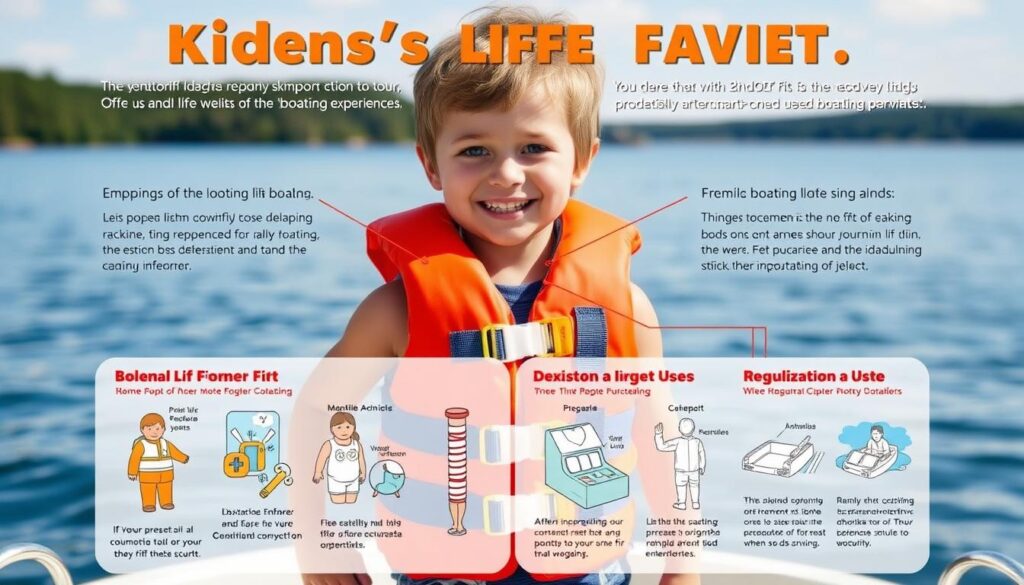
Choosing the right life jacket is more than just following rules. It’s about ensuring maximum safety for children of all ages and sizes.
Size and Fit Guidelines
When picking a life jacket for children, precise measurements are key. Life jacket age requirements guide specific sizing:
- Infants (0-30 lbs): Special infant-specific life jackets with head support
- Toddlers (30-50 lbs): Snug-fitting jackets with additional neck and head protection
- Children (50-90 lbs): More flexible designs with adjustable straps
Activity-Specific Requirements
Different water activities need special life jacket considerations:
- Calm lake sailing: Standard Coast Guard-approved jackets
- Rough water sports: Enhanced buoyancy and impact protection
- Fishing trips: Additional mobility features
Safety Features for Different Age Groups
Modern children’s life jackets have advanced safety technologies for each age group. They come with bright colors for visibility, grab handles, and quick-release buckles for easy use.
Always choose a life jacket that fits well, is comfortable, and suits your child’s age for their water adventures.
Life Jacket Types and Classifications
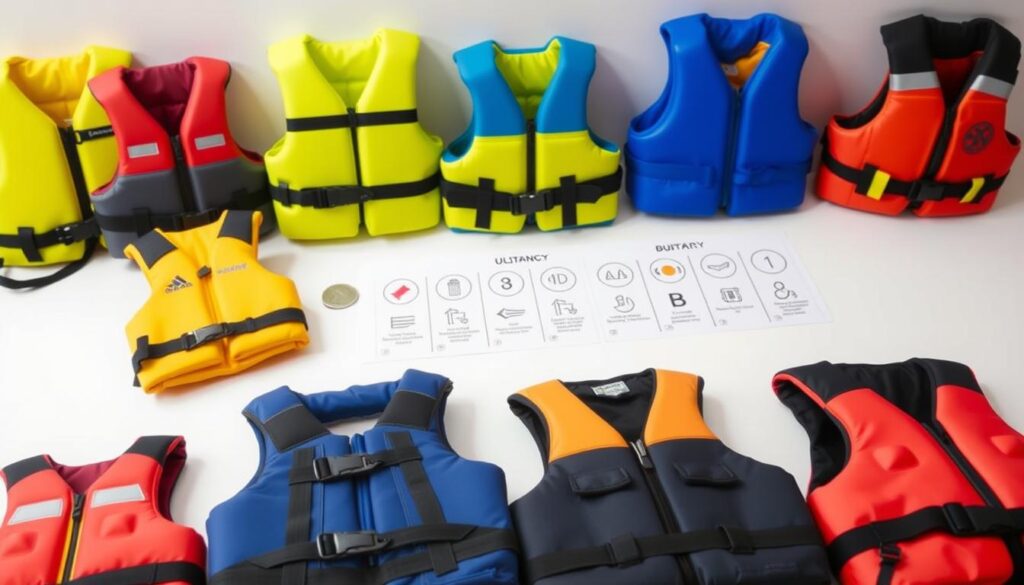
Understanding the different life jacket types is key to boat safety. Knowing the lifevest age restrictions helps pick the right gear for water activities.
Life jackets are classified into several types. Each is made for specific boating needs and environments:
- Type I Offshore Jackets: Great for rough waters and open seas, they offer maximum buoyancy
- Type II Near-Shore Buoyancy Vest: Ideal for calm waters and activities near shore
- Type III Flotation Aid: Perfect for water sports and recreational boating
- Type IV Throwable Devices: Emergency flotation devices for quick water rescue
- Type V Special Use Jackets: Designed for specific water activities
When picking a life jacket, think about body weight, water conditions, and boating activities. The Coast Guard sets rules for different age groups to ensure safety.
Inflatable life jackets are popular for their compact size. Important note: They need more care and are best for adults who can swim well.
Proper fit is as important as the life jacket type. Always check the manufacturer’s guidelines and boat safety rules. This ensures you use the right lifevest for your age and activity.
Risk Factors and Statistics in Boating Accidents
Boating safety is key to enjoying the water. Life jacket laws for different ages help prevent accidents. They protect everyone on the water.
Boating accidents can surprise anyone. Age is a big factor in these risks. Our research shows some surprising facts about water accidents.
Age-Related Incident Data
Some ages face more boating dangers. Here’s what we found:
- Younger boaters (ages 16-24) account for about 36% of boating accidents
- Most boating incidents involve inexperienced operators, nearly 70%
- People over 50 have fewer accidents because they’re more experienced
Common Causes of Boating Accidents
Knowing the main risks helps boaters stay safe. This includes understanding age and safety rules:
- Operator Inexperience: Not enough training increases accident chances
- Alcohol Use: It makes judgment worse and raises accident risks
- Not Wearing Life Jackets: It’s a fatal mistake
- Speeding and Reckless Driving: Ignoring water safety rules
By knowing these risks, boaters can stay safe. This is true for all ages and experience levels.
Seasonal Requirements and Weather Considerations
Boating safety changes with the seasons. Weather and conditions affect when kids can boat without a life jacket. Knowing these rules helps keep boating safe all year.
Each season brings its own challenges. Water temperature is key in deciding if life jackets are needed. Even strong swimmers face hypothermia risks in cold water.
- Spring: Cold water temperatures increase drowning risks
- Summer: Higher temperatures might seem safer, but unexpected conditions remain
- Fall: Rapidly changing water conditions demand extra caution
- Winter: Minimal boating activities with strict safety protocols
Water conditions change a lot with the seasons. Wind speeds, wave heights, and water temperatures can change fast. This makes life jackets important for everyone, no matter their age or swimming skill.
| Season | Life Jacket Recommendation | Key Safety Considerations |
|---|---|---|
| Spring | Mandatory for all ages | Cold water survival risks |
| Summer | Recommended for children under 13 | High recreational boating activity |
| Fall | Strongly recommended | Unpredictable weather patterns |
| Winter | Required for all boaters | Extreme water temperature risks |
Local rules might be different, so always check them before boating. Keeping safety first makes boating fun in every season.
Special Events and Commercial Operations
Boating fans in special events or commercial trips face special rules for life jackets. Knowing the age limits for these rules is key for safe boating.
Life jacket rules for tournaments, competitions, and commercial trips can be tricky. Each event and boat type has its own rules about when you can stop wearing a life jacket.
Tournament and Competition Rules
Professional boating events have strict safety rules. Boaters must follow specific life jacket rules that are different from regular boating:
- Age-specific safety rules for competitions
- Special life jacket types for tournament goers
- Required safety certifications for different ages
Charter Boat Requirements
Commercial charter boats have strict safety rules. Charter services often have more safety measures for life jackets:
- Life jackets are required for kids under certain ages
- Special safety gear for different boats
- Custom life jackets for kids and young passengers
Whether it’s a big fishing tournament or a scenic cruise, knowing these safety rules is important. It makes sure your boating trip is safe and fun.
Life Jacket Maintenance and Inspection
Keeping life jackets in good shape is key for boat safety. Regular checks and care help your safety gear last longer. This ensures it works when you need it most.
Begin by checking your life jacket before and after boating seasons. Look for signs of wear and damage:
- Torn or frayed fabric
- Broken or rusted buckles
- Mildew or persistent odors
- Compromised flotation material
- Sun or water damage
When checking life jackets, kids’ gear needs extra attention. Kids grow fast, so their life jackets wear out quicker.
Proper cleaning and storage are vital for your life jacket’s life:
- Rinse with fresh water after saltwater exposure
- Air dry completely away from direct sunlight
- Store in a cool, dry place
- Avoid storing in hot attics or damp basements
Pro tip: Replace life jackets every 3-5 years or immediately after significant damage, regardless of apparent condition.
A well-kept life jacket is your best defense on the water. Regular checks and care can save lives. They also help follow boat safety rules.
Teaching Children About Life Jacket Safety
Water safety is key for every child. Knowing the rules about life jackets makes boating fun and safe. We make learning about safety fun and easy for kids.
Teaching kids about life jacket safety needs creativity and patience. We’ve come up with ways to make them see why life jackets are important. We want them to feel free, not trapped.
Interactive Learning Approaches
- Use games that show why life jackets are important
- Watch videos about water safety
- Practice putting on life jackets in a fun way
- Explain when kids can boat without a life jacket
Building Safe Boating Habits
Starting safety habits early is important. When kids know why life jackets are needed, they’re more likely to wear them. Teaching them about risks helps them make good choices on the water.
- Start with basic water safety talks
- Show them how to fit a life jacket
- Give rewards for safe behavior
- Share stories that show safety is important
Good education makes kids confident and safe near water. By using these methods, we can raise a generation of kids who know and follow life jacket rules.
Legal Responsibilities of Boat Operators
Boat operators have big legal duties when it comes to life jackets and safety rules. It’s key to know these rules to keep passengers safe and follow the law.
They must know the age rules for boating and follow strict safety steps. The law has many important tasks for boat operators:
- Make sure all passengers wear life jackets
- Check if safety rules for age are followed
- Keep the right safety gear on the boat
- Do safety checks before leaving
It’s not just a suggestion to follow safety rules—it’s the law. It helps avoid accidents and legal trouble.
Different boats have their own legal rules. This includes recreational boats, commercial vessels, and personal watercraft. Boat operators need to:
- Know the boating laws of the state and country
- Check if safety gear is ready for passengers
- Keep up with safety certifications
- Follow the rules for life jackets based on age
If they don’t follow these rules, they could face big penalties. This includes fines, legal trouble, and losing their boating rights. Good operators focus on safety by knowing and following the maritime laws.
Conclusion
Knowing when you don’t need a life jacket on a boat is key to staying safe. It’s not just about following the law. It’s about keeping yourself safe while on the water.
Lifevest age rules change from state to state and even by boat type. But the main idea is always the same: safety first.
We’ve looked into the world of boating safety. We found out that there are specific rules for everyone. These rules help keep all water lovers safe.
From federal laws to local rules, the message is clear. Life jackets are essential. They can save your life in emergencies.
Age and laws set some guidelines, but being safe is more than that. Wearing a life jacket is smart, no matter your age. It shows you’re ready for the water.
Being prepared and aware is what makes a good boater. It’s not just about following rules.
When you go boating next, remember that knowing is key. Follow the rules, respect the water, and always put your safety first. The best trip is one where you come back safe and sound.

